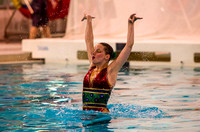There are different streams for different types of athletes in every sport. The different streams in synchronized swimming require different levels of competence from their athletes.
Recreational level athletes do not require a specific body type or any kind of specific cellular characteristics in order to be allowed into the program. Anyone can join recreational synchro though having a certain body type or useful cellular characteristics can contribute to the swimmer’s success in the sport. These swimmers can generally eat whatever they want, as long as they stay healthy, to be able to swim. There are no real dietary restrictions. They also have a very laid back and fun training program that doesn’t require that much dedication from the swimmers or their families.
Competitive has a few more specific requirements in order to truly succeed at your age level. Swimmers with a mesomorphic body type generally succeed more in synchro at the competitive level. Swimmers that have a medium metabolism, a good circulatory system, and muscles that contract efficiently and are mostly type IIA muscle fibres generally are more successful. These characteristics do not determine whether you are able to participate in the sport which is what makes it different from Olympic level. Competitive swimmers have to be more health conscious but mostly just before a competition. While away at competitions the teams eat as healthily as possible and the athletes are encouraged to the same at home leading up to the competition. As for training, competitive level swimmers train significantly more than the recreational level but significantly less than at the Olympic level.
Olympic swimmers have the most requirements as to whether they can be involved in the Olympic stream or not. They must be a mesomorph with a medium metabolism, excellent circulatory system, and mostly consist of type IIA muscle fibres. All these elements are important since there are so many people trying to join the Olympic stream so having any kind of advantage over other athletes can help a specific athlete get onto the team. Olympic swimmers also have a very restricted diet that fuels their body for practices and competitions without changing their body composition or affecting their body fat and muscle mass. They also have very high intensity training programs that all lead up to one goal; the Olympics and that podium. It is all these elements that allow these athletes to make it there, make it to gold.
Overall synchronized swimming is a very women positive sport and influences so many young women. Here are two articles written by two previous Nepean Synchro athletes on their love for synchro. The first is written by Greer Gemin who swam with Nepean for 7 or more years and continues to coach with them now. (Gemin, G. (2013, April 1)) https://docs.google.com/viewer?a=v&pid=sites&srcid=ZGVmYXVsdGRvbWFpbnxuZXBlYW5zeW5jaHJvMXxneDo4NjlmZmU0MTU5ZTUxNDU
Greer Gemin swimming her solo to Amelie in 2014 (http://danrobichaud.zenfolio.com/img/s2/v72/p1472677752-11.jpg)
The second article is written by Lily Dong who swam for 8 or more years and coaches now with London Synchro in London Ontario. (Dong, L. (2014, June 16)) https://docs.google.com/viewer?a=v&pid=sites&srcid=ZGVmYXVsdGRvbWFpbnxuZXBlYW5zeW5jaHJvMXxneDoyYTRhNDMwNDdiN2EwM2I3
Lily Dong’s coach profile photo on London Synchro’s website 2015
Both of these women were incredibly dedicated athletes in the competitive stream who coached recreational swimmers to share their love for synchro with young girls and continue to do that even now. (http://www.nepeansynchro.com/2014-15-recreational-season/join-our-club)

